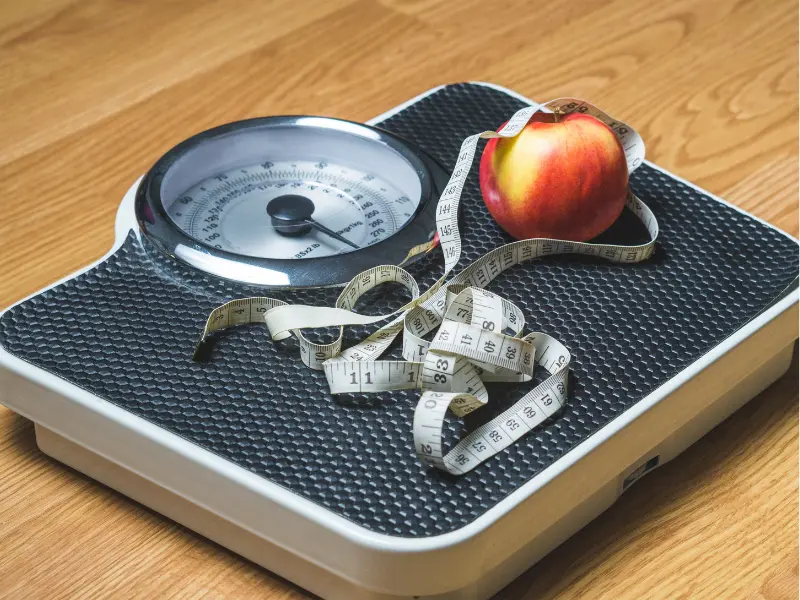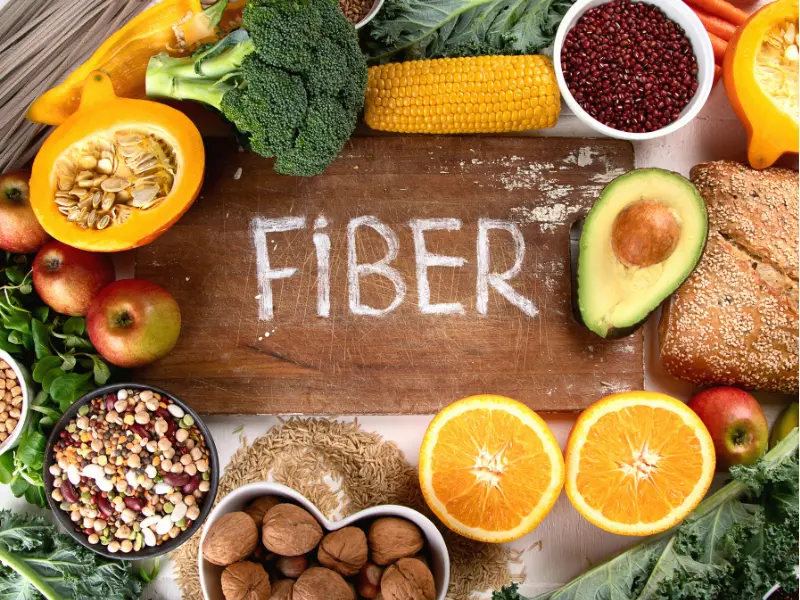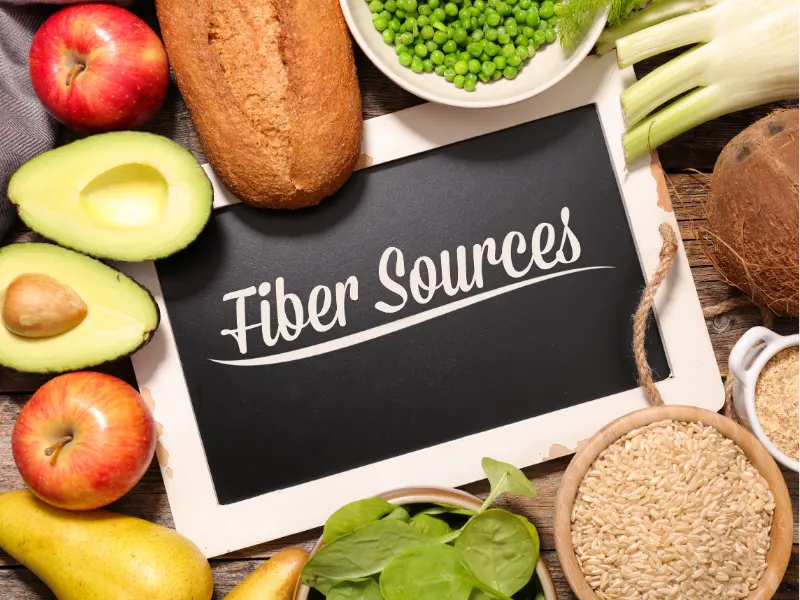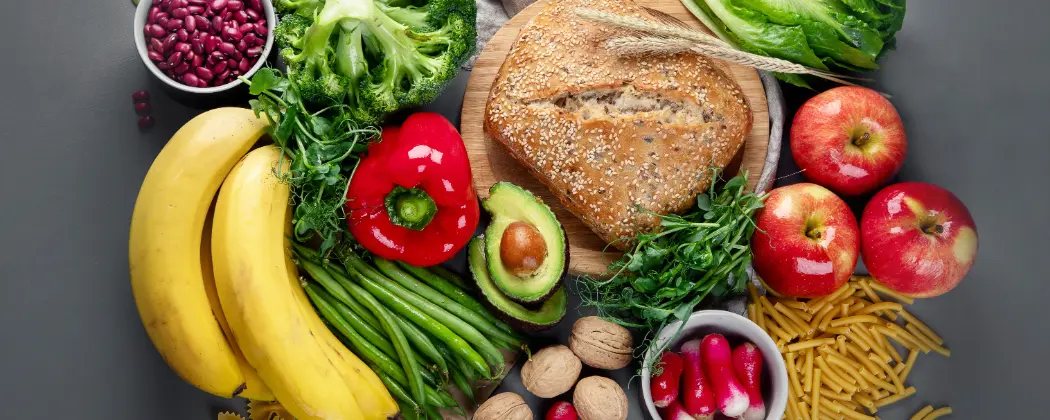Are you looking to shed those extra pounds? A fiber-rich diet could be your key to sustainable weight loss. Fiber helps you feel fuller longer, supports healthy digestion, and stabilizes blood sugar levels.
Consuming 30-40 grams of fiber daily can help you lose weight as effectively as more complicated diets. This nutrient creates a feeling of satiety that naturally reduces calorie intake without leaving you deprived or hungry between meals.
Incorporating fresh fruits, vegetables, whole grains, and legumes into your daily meals is an easy way to increase your fiber intake.
These foods supply the fiber your body needs and essential vitamins and minerals that promote overall health while helping you achieve your weight loss goals.
Understanding Fiber and Weight Loss

Fiber is critical in weight management because it promotes fullness, stabilizes blood sugar levels, and supports digestive health. Research consistently shows that individuals who consume adequate fiber tend to maintain healthier weights and experience greater success during weight loss efforts.
What Is Dietary Fiber?
Dietary fiber is a carbohydrate in plant foods that your body cannot digest or absorb. Unlike other carbohydrates, fiber passes through your digestive system relatively intact.
Fiber is naturally present in fruits, vegetables, whole grains, legumes, nuts, and seeds. Most plant-based foods contain a mixture of different fiber types.
The recommended daily intake for adults is 30-40 grams, though most people consume only about half that amount. This fiber gap may contribute to weight management difficulties and other health issues.
Fiber adds bulk to your diet without adding calories, making it essential for weight loss strategies. Your body expends energy to process fiber, slightly increasing your metabolic rate.
Not eating enough fiber can make it harder to manage your weight.
Louise Vafi Tweet
Types of Fiber: Soluble vs. Insoluble
Soluble fiber dissolves in water, forming a gel-like substance in your digestive tract. It slows digestion, helping you feel full longer and stabilizing blood sugar levels.
Foods rich in soluble fiber include:
- Oats and barley
- Beans and lentils
- Apples, citrus fruits, and berries
- Flaxseeds and chia seeds
Insoluble fiber does not dissolve in water but adds bulk to stool. It helps food pass quickly through the stomach and intestines, promoting regular bowel movements.
Good sources of insoluble fiber include:
- Wheat bran and whole grains
- Nuts and seeds
- Vegetables like cauliflower and green beans
- Fruit skins
Both types work together to support weight loss efforts. However, soluble fiber tends to have more direct effects on appetite regulation.
How Fiber Affects Appetite and Satiety
Fiber creates a physical feeling of fullness by adding volume to foods without significant calories. High-fiber meals require more chewing, slowing your eating and giving your body time to register fullness signals.
Soluble fiber forms a gel in your stomach that delays emptying, extending feelings of satisfaction after meals. This helps prevent overeating and reduces total calorie intake throughout the day.
Fiber-rich foods also tend to have a lower glycemic index, preventing blood sugar spikes and crashes that can trigger hunger. This stable blood sugar environment helps control cravings and emotional eating.
Research shows that increasing fiber intake by just 14 grams per day is associated with a 10% decrease in calorie consumption. You’ll naturally eat less without feeling deprived or hungry.
Benefits of a Fiber-Rich Diet for Weight Loss

Incorporating adequate fiber into your diet provides multiple advantages when losing weight. Fiber works through several mechanisms to support weight management and improve overall health.
Enhanced Fullness and Reduced Calorie Intake
Fiber-rich foods take longer to eat and digest, helping you feel satisfied with fewer calories. When you consume high-fiber foods like vegetables, fruits, and whole grains, they absorb water in your digestive tract, creating a feeling of fullness.
Soluble fiber forms a gel-like substance in your stomach that slows digestion and the rate at which nutrients are absorbed. This prolonged digestive process keeps you feeling full for hours after eating, reducing between-meal snacking and overeating.
Regulation of Blood Sugar Levels
Fiber helps moderate blood glucose levels by slowing sugar absorption into your bloodstream. This prevents the insulin spikes and crashes that often trigger hunger and cravings.
The steady energy released from fiber-rich foods helps maintain consistent energy levels throughout the day. You’ll experience fewer energy slumps that might otherwise lead to reaching for high-calorie snacks.
Research indicates that people who consume more dietary fiber have a 20-30% lower risk of developing type 2 diabetes. This blood sugar regulation is particularly beneficial if you lose weight and improve metabolic health.
Improved Digestive Health
A fiber-rich diet promotes regular bowel movements and prevents constipation, which can cause bloating and discomfort. Regular elimination helps maintain a flatter stomach and reduces water retention.
Fiber acts as a prebiotic, feeding beneficial gut bacteria that support metabolism and overall health. These bacteria produce short-chain fatty acids that may help regulate fat storage and improve insulin sensitivity.
Key digestive benefits of fiber include:
- Reduced inflammation in the digestive tract
- Prevention of diverticular disease
- Support for detoxification processes
- Maintenance of intestinal barrier function
Better digestive health translates to improved nutrient absorption, giving your body the resources it needs during calorie restriction.
How to Incorporate Fiber into a Weight Loss Plan

Adding more fiber to your diet requires strategic food choices, understanding proper intake amounts, and planning meals that maximize fiber’s weight loss benefits.
Choosing High-Fiber Foods
Start by incorporating more fruits like berries, apples, and pears, which contain 3-8 grams of fiber per serving. Include vegetables such as broccoli, carrots, and Brussels sprouts at every meal—they’re low in calories but high in fiber.
Whole grains should replace refined carbohydrates in your diet. Choose oats, quinoa, brown rice, and 100% whole wheat bread instead of white flour. These options provide 3-5 times more fiber.
Legumes deserve special attention in a high-fiber weight loss plan. Beans, lentils, and chickpeas offer 7-15 grams of fiber per cup while providing plant protein that helps maintain muscle during weight loss.
Top Fiber-Rich Foods:
- Chia seeds (10g per ounce)
- Split peas (16g per cup, cooked)
- Artichokes (10g per medium artichoke)
- Avocados (9g per cup)
Daily Fiber Recommendations
For effective weight loss, women should aim for 25-30 grams of fiber daily and men for 30-38 grams. This amount helps create satiety while supporting digestive health.
Track your fiber intake for the first few weeks to ensure you’re meeting targets. Many food-tracking apps can help you monitor your daily consumption and identify areas for improvement.
Increase your fiber intake gradually over 2-3 weeks to avoid digestive discomfort. Adding too much fiber too quickly can cause bloating, gas, and abdominal pain.
Drink plenty of water with your high-fiber diet—at least 8-10 glasses daily. Fiber works best when it absorbs water, creating bulk that helps you feel full longer and supports healthy digestion.
Meal Planning Strategies
Start your day with fiber by choosing overnight oats with berries (10g fiber) or a chia seed pudding (12g fiber) for breakfast. These options provide long-lasting energy and satisfaction.
For convenient weekday options, prepare batch-cooked high-fiber meals like bean chili, lentil soup, or quinoa bowls. Having these ready reduces the temptation to choose lower-fiber alternatives.
Use the plate method for balanced, fiber-rich meals: fill half your plate with vegetables, one quarter with whole grains, and one quarter with lean protein—ideally including legumes.
Add “fiber boosters” to everyday foods: sprinkle ground flaxseeds on yogurt, mix chia seeds into smoothies, or add beans to salads and soups. Each tablespoon of these boosters adds 2-5 grams of fiber.
Snack strategically with options like raw vegetables with hummus, an apple with almond butter, or a small handful of nuts. These combinations provide fiber along with protein or healthy fats for better satiety.
Best Sources of Fiber for Weight Loss

Fiber-rich foods can significantly boost your weight loss efforts by promoting satiety and improving digestive health. The following sources provide exceptional fiber content while supporting your weight management goals.
Whole Grains
Whole grains contain all parts of the grain kernel, providing substantial fiber and nutrients. Oats are particularly effective for weight loss, delivering 4 grams of fiber per cup while releasing energy slowly to keep you full longer.
Barley ranks among the highest-fiber whole grains, with 6 grams per cup, and has been shown to reduce hunger hormones. Brown rice, though lower in fiber than other whole grains (3.5 grams per cup), still offers steady energy release without blood sugar spikes.
Quinoa provides 5 grams of fiber per cooked cup and complete protein, making it ideal for post-workout recovery. Whole wheat products such as bread and pasta should replace refined versions—look for “100% whole wheat” on labels to ensure you’re getting the fiber benefits.
Legumes and Pulses
Lentils deliver an impressive 15.6 grams of fiber per cooked cup while providing plant protein that helps preserve muscle mass during weight loss. Their low glycemic index helps prevent insulin spikes that can trigger hunger.
Black beans contain 15 grams of fiber per cup and have been linked to reduced belly fat in studies. Their resistant starch acts as a prebiotic that feeds beneficial gut bacteria.
Chickpeas offer 12.5 grams of fiber per cup and contain compounds that may reduce fat storage. Try roasting them for a crunchy, high-fiber snack alternative to chips.
Split peas provide 16.3 grams of fiber per cup, among the highest of all legumes. Research shows that regular consumption of pulses can lead to 0.75 pounds more weight loss than diets without them.
Fruits and Vegetables
Berries are among the most fiber-rich fruits, with raspberries providing 8 grams per cup and blackberries offering 7.6 grams. Their high water content and low-calorie density make them ideal for weight loss.
When eaten with skin, pears and apples contain 5.5 and 4.5 grams of fiber, respectively. The soluble fiber in these fruits forms a gel-like substance that slows digestion and improves satiety.
Avocados deliver 10 grams of fiber per cup while providing healthy fats that enhance nutrient absorption. Studies show that despite their calorie content, avocado consumers tend to have lower body weights.
Cruciferous vegetables like broccoli (2.4g fiber per cup) and Brussels sprouts (4g per cup) offer fiber and compounds that may assist with fat metabolism. Artichokes stand out with 10.3 grams of fiber per medium vegetable, one of the highest among all vegetables.
Nuts and Seeds
Chia seeds provide an exceptional 10 grams of fiber per ounce and expand in your stomach to increase fullness. Studies show they can reduce hunger hormones when consumed before meals.
Flaxseeds contain 7.8 grams of fiber per ounce and deliver omega-3 fatty acids that may help reduce obesity-related inflammation. Grinding them improves nutrient absorption.
Almonds offer 3.5 grams of fiber per ounce, protein, and healthy fats that increase satisfaction. Research indicates that regular almond consumption is associated with greater weight loss.
Pumpkin seeds provide 5 grams of fiber per quarter cup and contain magnesium, a mineral that helps regulate blood sugar. Their protein content (9g per quarter cup) further supports appetite control and muscle maintenance during weight loss.
Potential Challenges and Solutions
Chia seeds provide an exceptional 10 grams of fiber per ounce and expand in your stomach to increase fullness. Studies show they can reduce hunger hormones when consumed before meals.
Flaxseeds contain 7.8 grams of fiber per ounce and deliver omega-3 fatty acids that may help reduce obesity-related inflammation. Grinding them improves nutrient absorption.
Almonds offer 3.5 grams of fiber per ounce, protein, and healthy fats that increase satisfaction. Research indicates that regular almond consumption is associated with greater weight loss.
Pumpkin seeds provide 5 grams of fiber per quarter cup and contain magnesium—a mineral that helps regulate blood sugar. Their protein content (9g per quarter cup) further supports appetite control and muscle maintenance during weight loss.
Incorporating more fiber into your diet may present certain obstacles. Still, with the right approach, these challenges can be effectively managed.
Minimizing Digestive Discomfort
Increased fiber consumption can initially cause bloating, gas, or stomach cramps. These symptoms occur as your digestive system adjusts to processing more fiber.
To reduce discomfort, choose soluble fiber sources like oats and barley, which are gentler on your system. Consider taking a digestive enzyme supplement before fiber-rich meals to help break down complex carbohydrates.
Cooking vegetables thoroughly can make them easier to digest than raw options. Steaming or roasting cruciferous vegetables like broccoli and cauliflower breaks down some compounds that cause gas.
Simple relief methods:
- Take a short walk after meals
- Apply a warm compress to your abdomen
- Try peppermint tea to relax digestive muscle
Gradually Increasing Fiber Intake
A common mistake is adding too much fiber too quickly. Your body needs time to adjust to higher fiber levels.
Add 2-3 extra grams of fiber daily for a week, and then increase by another 2-3 grams the following week. This slow progression allows your digestive bacteria to adapt properly.
Track your fiber intake using a food journal or app to ensure steady, manageable increases. Aim to reach the recommended 25-30 grams daily, but recognize this may take 4-6 weeks.
Sample gradual introduction plan:
| Week | Additional Fiber | Easy Addition Options |
|---|---|---|
| 1 | +3g | Add 1/2 cup berries to breakfast |
| 2 | +5g | Include a small salad at lunch |
| 3 | +8g | Add beans to one meal daily |
Hydration and Its Importance
Fiber absorbs water in your digestive system. Without adequate hydration, increased fiber can worsen constipation instead of helping.
When following a high-fiber diet, aim to drink at least 8-10 cups (64-80 ounces) of water daily. Carry a reusable water bottle with measurement markings to track your daily intake.
Notice the color of your urine—pale yellow indicates proper hydration, while dark yellow suggests you need more fluids immediately.
Hydration boosting strategies:
- Add flavor with cucumber, lemon, or berries if plain water is unappealing
- Set phone reminders to drink water hourly
- Consume water-rich foods like watermelon and cucumber alongside fiber-rich foods
Your fluid needs may increase with exercise or hot weather, so adjust accordingly when pursuing weight loss through a fiber-rich diet.
Lifestyle Factors to Maximize Results

Combining a fiber-rich diet with complementary lifestyle changes significantly enhances weight loss outcomes. These adjustments work synergistically with dietary fiber to accelerate progress and maintain results long-term.
Physical Activity and Fiber
Regular exercise amplifies the benefits of your high-fiber diet. Aim for at least 150 minutes of moderate-intensity activity weekly, such as brisk walking, swimming, or cycling. This combination helps create a larger calorie deficit while preserving muscle mass.
Timing matters, too. Consider consuming fiber-rich foods 1-2 hours before exercise to maintain steady energy levels without digestive discomfort. Post-workout, high-fiber meals support recovery and prolong satiety.
Strength training deserves special attention. Adding 2-3 resistance sessions weekly helps build metabolically active muscle tissue. Your body burns more calories even at rest, making your fiber-rich diet more effective for weight management.
Exercise/Fiber Synergy:
- Morning fiber + afternoon workout = improved energy regulation
- Strength training + adequate fiber = better recovery and muscle preservation
- Consistent activity + high fiber = reduced inflammation markers
Consistency and Tracking Progress
Maintaining a fiber-rich eating pattern requires planning. Use a food journal to record daily fiber intake, aiming for gradual increases until you reach 25-38g daily. This prevents digestive discomfort while ensuring progress.
Tracking non-scale victories proves especially valuable. As fiber intake increases, note improvements in energy levels, digestion, and hunger patterns. Many people report reduced cravings and more stable moods within 2-3 weeks.
Consider using a simple measurement system:
- Waist circumference (weekly)
- Energy levels (daily rating 1-10)
- Fiber intake (grams per day)
Digital tools can streamline this process. Many nutrition apps now specifically track fiber intake alongside other nutrients. Set reminders to ensure you consume fiber throughout the day rather than all at once.
Consistency trumps perfection. Moderate fiber intake daily will achieve better results than sporadic high-fiber days followed by low-fiber periods.
Common Myths About Fiber and Weight Loss
Many people believe that all fiber is created equal in terms of weight loss. This isn’t true – soluble and insoluble fiber work differently in your body, with soluble fiber being particularly beneficial for weight management.
Another common misconception is that fiber supplements are as effective as natural food sources. While supplements can help increase your fiber intake, whole foods provide additional nutrients and create greater satiety.
Some think more fiber always equals more weight loss. Your body needs time to adjust to increased fiber intake. Adding too much too quickly can cause bloating and discomfort without enhancing weight loss benefits.
The myth that fiber has no calories persists despite being false. Soluble fiber contains approximately two calories per gram – less than other carbohydrates but not zero.
Many people believe fiber-rich foods are always low in calories. However, some fiber-rich foods, such as nuts, avocados, and granola, contain significant calories despite their fiber content.
“Fiber cancels out other calories” is a popular but inaccurate belief. While fiber may reduce the absorption of some calories, it doesn’t eliminate or “cancel” calories from other foods you consume.
Some think you need expensive specialty foods to get enough fiber. Affordable options like beans, lentils, oats, and seasonal fruits and vegetables provide excellent fiber sources without the premium price tag.
When to Seek Professional Support

While a fiber-rich diet can be beneficial for weight loss, there are times when professional guidance becomes necessary. Consulting with healthcare providers ensures your weight management approach is safe and effective.
Signs you should consult a healthcare professional:
- Unexplained weight gain despite following a high-fiber diet
- Digestive issues that worsen with increased fiber intake
- Extreme fatigue or weakness
- Persistent hunger despite adequate calorie intake
Suppose you have pre-existing health conditions such as irritable bowel syndrome, Crohn’s disease, or diverticulitis. In that case, professional advice is crucial before significantly increasing your fiber intake. These conditions may require specialized dietary approaches.
Nutritionists and dietitians can provide personalized fiber recommendations based on your unique needs. They can help you create a balanced meal plan incorporating appropriate fiber sources without causing digestive distress.
If you’ve tried multiple diet approaches without success, consider seeking professional support. A healthcare provider can assess potential underlying issues hindering your weight loss progress.
When to consult specific professionals:
| Professional | When to seek their help |
|---|---|
| Dietitian/Nutritionist | For personalized meal planning and fiber recommendations |
| Primary Care Physician | For unexplained symptoms or weight issues |
| Gastroenterologist | For persistent digestive problems related to fiber intake |
Remember that proper fiber intake varies based on age, sex, and health status. Your healthcare provider can help determine the optimal amount for your specific situation.
References
Effects of Dietary Fiber and Its Components on Metabolic Health (2010).
James M Lattimer, Mark D Haub.
Fiber Intake Predicts Weight Loss and Dietary Adherence in Adults Consuming Calorie-Restricted Diets: The POUNDS Lost (Preventing Overweight Using Novel Dietary Strategies) Study (2019). Derek C Miketinas et al.
Position of the Academy of Nutrition and Dietetics: Health Implications of Dietary Fiber (2015) Wendy J Dahl et al.
Impact of Dietary Fiber Consumption on Insulin Resistance and the Prevention of Type 2 Diabetes (2017). Weickert Martin, Pfeiffer Andreas.
British Heart Foundation, Pulses: what they are and why they’re good for you
A Comprehensive Review of Almond Clinical Trials on Weight Measures, Metabolic Health Biomarkers and Outcomes, and the Gut Microbiota (2021) Mark L Dreher

